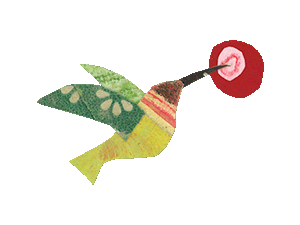How Storytelling Leads to Productive Solo Play
Note: We are reaching out to storytellers, parents, and children all over the world to collect stories that bring a little healing and levity to the coronavirus outbreak. We believe families need tools to help children (and parents) deal with the anxiety and cabin fever, not just the virus. Storytelling is a time-tested way to build safety, intimacy, and creativity in the home.
Visit the Coronavirus Storytelling Home Page
To be clear - these stories, articles, and resources are intended to help parents guide young children and ease anxiety in the household after the serious work of preparation has been done. They are not intended to make light of the illness. While this and other stories can be shared directly with children, we believe you will find the greatest comfort in crafting stories of your own with the help of your child.
If you've ever wondered why your three- or four-year-old doesn't play by himself (and it's maybe driving you a little crazy), try this.
I recently read a headline in a popular parenting magazine titled, "Most Toys Suck." I appreciated the brevity of that statement, but the article failed to flesh out why. Most toys "suck" because it's not the toy a child craves - it's the story! Storytelling isn't just a way to pass the time. It is a way to give a child a cohesive narrative - the real backbone of lasting and creative play.
Storytelling leads directly to productive play because children usually "pick up the story" once it's finished. In other words, they take on the characters, settings, and imaginative structures for themselves - empowering them to explore it on their own. These are imaginative structures, not physical items. In other words, by TELLING a child a story, you are GIVING them a framework to explore their own imagination through further play.
This is the opposite of boredom, which is a lack of engagement, and it's obvious how a child picks up a story if you've ever watched a movie together. But your child will pick up almost any story you've told, and if you get good at it you can build stories into the very framework of your house (or car, whatever). The freedom this gives to parents is priceless.
A child of 4-6 years often only requires a good story, but if your child is a little younger it can help to have a few props - dolls or toy trucks you've incorporated into your story (or sometimes just a few good sticks). These physical materials make it even easier for a young child to "pick up" the imaginary materials you're handing them.
Here's an Example
Mom is exhausted from a long day of being mom, yet her son is still clamoring for more mommy time. Instead of pulling her hair out, mom grabs a stuffed penguin and tells a quick story that is entertaining to her - to mom! - about a penguin that loves floating on ice rafts (she grabs a coaster) and sliding down armrests. He goes on long adventures from chair to chair, couch to table, floating on his ice raft and meeting strange fish that live beneath the floor. Such a story can be told in five minutes.
If this is the first time mother has ever told a story, her son may look at her with awe and curiosity, which will be reward enough. But if they have already established a storytelling relationship, it's very likely that the child will take up the story for himself, visiting the next chair on his own, and the next, looking for more fish.
This is how storytelling leads to productive play, and a little bit of practice will turn any worn out parent into a mastermind of imaginative engagement. And you don't need to buy anything. It's only incidental that mom then has a few quiet minutes to herself, but this can be a godsend.
In time, mom can "give" her son dozens of stories, all of which have physical components in his day to day life, so that when the young boy walks through his house he sees stories in every corner. It’s easy for him to engage.
This is a child that loves mom, yet is engaged in productive solo play. This is a child that sees imaginary doors in common objects all over his house. This is a child with an engaged nervous system that is learning to explore his brain through things he sees everyday.
This is a mom that’s chillin’.
Announcing the 2020 Coronavirus Storytelling Challenge
As politicians and journalists wrestle for control over the story of coronavirus in the media, parents are locked down in a different battle – the story forming in our children’s hearts.
Schools are closing their doors. Parents are feeling anxious. Social distancing and empty shelves have us gasping for normalcy. We need skills for handling the disease, but we also need tools for managing the anxiety that treads in its footsteps.
That’s why we created the 2020 Coronoavirus Storytelling Challenge. As the nation struggles to catch up with the disease, let’s help parents and children connect at home, and take some of the pressure off.
PS - We want stories from parents and kids at home too! Not just storytellers. Share yours!
The Storytelling Loop is a newsletter bringing you tips, science, and real-life examples of how storytelling builds the connection between parent and child. It is a joint project of Silke Rose West and Joseph Sarosy, authors of How to Tell Stories to Children. Originally published in August of 2019, a new edition is due out from Houghton Mifflin Harcourt in 2021. You can find more from Joseph Sarosy at Fatherly. Are you involved in storytelling? Join Us.


